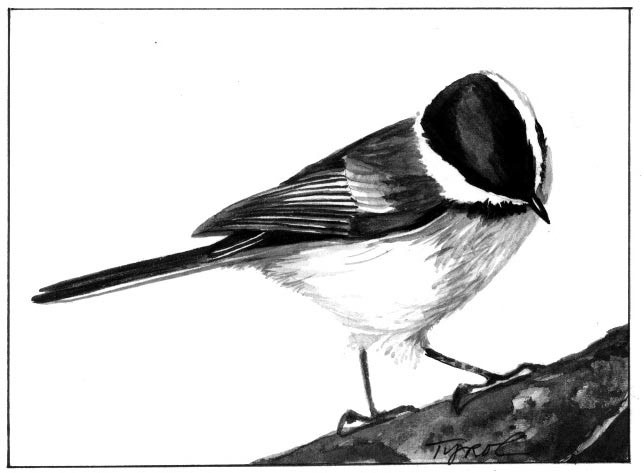
The next time you are rushing around your house looking for your car keys, you might think about the chickadees at your bird feeders. Each fall, black-capped chickadees grow new brain cells that seem to help them remember the locations of things.
Because chickadees are so small, it takes a lot of food during the winter for them to stay warm and alive. A chickadee weighs about the same as two quarters and will easily fit on the palm of your hand. Chickadees have a high surface-area-to-volume ratio, which means that heat loss through radiation during the cold winter can be acute. Combine this with the short daylight hours in which to forage for food, and energy can be a problem.
Chickadees prepare for the onslaught of winter by storing food. Watch them at your feeders in the fall, and you will notice that they eat some of the seed, but they also carry away one seed at a time, trip after trip. They stuff the seeds in the cracks of tree bark or even in little holes and cracks on your house. I have often found a few seeds crammed into little holes when painting my house.
Chickadees store thousands of food items a year. Each cache is usually used only one time. One study found that the birds could find a cache up to 28 days later. How do they find these sites when they need them most? Since songbirds have a very poor sense of smell, they cannot be tracking the seed down like a dog.
Experiments have shown that chickadees use a complex hierarchy of visual and spatial clues to return to each cache. They search in places suggested by large landmarks such as the arrangement of trees or buildings. Then they cue on local items such as a certain tree, and then by things right around the cache site, such as a patch of lichen on tree bark.
In 1994, Dr. David Brodbeck, at the time a student at the University of Toronto and now a professor at Memorial University of Newfoundland, set up an array of four feeders in an aviary. The feeders were all differently colored and in random locations. One of the feeders was baited with a peanut shoved into a little hole. A chickadee was placed in the aviary, and it would quickly find the peanut. It was allowed to eat for 30 seconds, and then it was removed from the aviary to its home cage for five minutes.
“After four minutes of reading the sports section, I would go into the aviary and cover up the holes on each feeder with little Velcro circles”, says Brodbeck. “The bird was let back in and had to find the baited feeder and remove the Velcro and eat.”
“They were pretty darn good at this, getting around 80 percent correct in their first look,” said Brodbeck. The chickadees’ first clue was the spatial location in the aviary; the second clue was the position in the feeder array (second from the left for example); and the third was the color.
“Spatial cues are more stable than, say, color, and chickadees need to remember where their food is in the morning when they get up, or they die. Simple as that,” said Brodbeck. “So they seem to have some sort of specialized memory system.”
With a brain the size of a pea, how do they remember all the cache locations? They grow extra brain cells. The hippocampus region of their brains expands in volume approximately 30 percent each fall with the addition of new nerve cells. This region of the brain is an important area for making new memories, especially spatial memories. Chickadees with lesions of the hippocampus continue to cache food and search for cache sites, but they are unable to find them.
The addition of new cells and the size of the hippocampus fluctuate seasonally in chickadees, with the peak in the fall during the food cache season and the valley during the summer when food caches are not necessary. It is probably energetically costly to maintain those brain cells, so when they don’t need them in the summer, they let the cells die off.
Many of the degenerative brain diseases in humans involve the hippocampus. The hippocampus in Alzheimer’s patients, for example, shrinks. Perhaps ongoing studies that seek a deeper understanding of songbird hippocampus regeneration will someday lead to applications in humans.
It turns out that you aren’t a birdbrain after all for losing your keys once again. You’re actually a squirrel brain. They store a lot of nuts, but apparently don’t have the trick of growing larger brains each year.


Discussion *